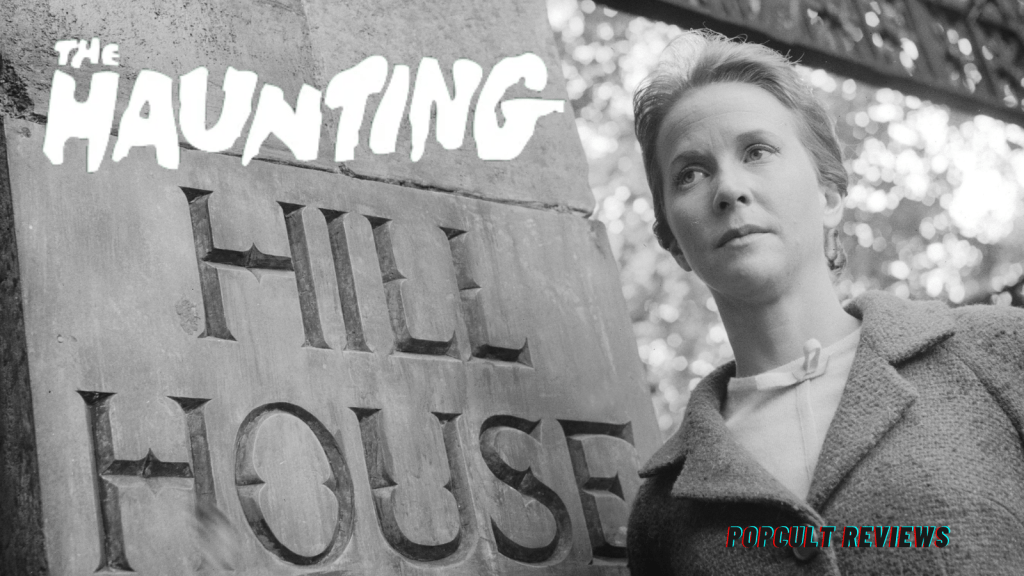The Haunting (1963)
Written by Nelson Gidding
Directed by Robert Wise
Haunted houses are not something new. Books, movies, comics, and every other form of media have presented haunted houses in one form or another to the point they have become relatively cliche. In today’s world, poorly made “ghost hunter” television shows and web series are a dime a dozen. The film The Haunting is the product of two minds: the author of the original novel Shirley Jackson and the director/producer Robert Wise. Through each artist, this story delivers a haunted house story unlike many that had come before and essentially shaped the subgenre going forward to the present; even those “ghost hunter” shows are profoundly influenced by this story.
Dr. John Markaway is keen to investigate Hill House, a 90-year-old estate in Massachusetts which has seen tragedy after tragedy befall its owners. In the years that followed, stories grew that it was haunted by powerful & angry spirits which intrigue the doctor. Markaway invites people to the house for his investigation. Only two agree to come: Theodora, a psychic, and Eleanor Vance, a woman who encountered a poltergeist as a child. Mrs. Sanderson, the current owner of the house, insists that her son Luke (Russ Tamblyn) attend to ensure the house is not damaged. A survey of the house reveals its construction was deliberately strange; walls were constructed with askew angles, which make things off-center and cause doors to often close on their own. During the night, loud noises disrupt the people’s sleep, and the house tries to drive them out. The more Markaway pushes back against the presence in the house, the angrier it gets leading toward a horrifying finale.
Robert Wise was wrapping up production on West Side Story when he read a review of Shirley Jackson’s novel in the pages of Time. Wise read the book and asked his writing collaborator Nelson Gidding to pen a treatment so they could option it as a film. Gidding’s reading of the story reinterprets the events in the subtext: This is actually a story about the mental breakdown of Eleanor, with Hill House being how she sees her mental hospital surroundings and Dr. Markaway as the attending physician. The duo traveled to Shirley Jackson’s home and met with her, sharing this concept. She told the men it was a very clever reinterpretation but that her book was clearly about the supernatural. They pushed this alternate reading into the background of the film’s text but still let ambiguity about Eleanor’s sanity remain without undermining Jackson’s original vision.
The Haunting is entirely about not seeing the ghosts but being in the presence of something evil. This isn’t a horror story about getting slashed into pieces or buckets of blood. Instead, the horror at the film’s heart is about the seduction of oblivion, being lured to death at the promise of finding a home in death. The looming threat powers the drama engine in the story, the characters coming face to face with some twisted aspect of human existence that cannot be quantified or explained. It is simply contained in this house, emanating pure evil from every rafter and crack in the wall.
Eleanor is the film’s protagonist and watching how the camera frames her is vital. Time and again, she’s seen in mirrors or on other reflective surfaces, which is meant to underline a mirroring of her identity. Eleanor is an individual and part of this makeshift group of supernatural investigators. However, she is also somehow part of the house. Maybe she was marked as a child when she witnessed a poltergeist, or perhaps it was when she walked into Hill House. More disturbing, maybe she was always meant to end up in this place, meeting her destiny at the top of the rickety staircase? In the same manner, Jack Torrance is implied to have always been a part of the Overlook Hotel in Kubrick’s The Shining; Eleanor has always been a part of Hill House.
Different characters serve as mirrors to Eleanor. Her fear is reversed in Theodora, a woman with seemingly unshakable confidence. Eleanor also has a reversed parallel in Luke; while she is a true believer, he remains a skeptic until he cannot. Dr. Markaway believes he can tame the entities while Eleanor feels drawn to them, letting the ghosts hold power. Eleanor is filled with a sense of needing to belong, and that desire is what inevitably reveals to her that she will become part of Hill House’s dark history. In many ways, Eleanor’s horror is based on her belief that she must belong to something larger to matter, and what is available for her to belong to isn’t very heartening. This person is without a self because she has lived her entire life trying to define that through others. What we see of her is a poor reflection on mirrored glass for others to observe, with nothing beneath the surface.
The Haunting is psychological horror at its purest, not letting the torment of its characters be diminished by cheap special effects. It just wouldn’t feel right to see the ghosts in this context. The Netflix mini-series does a decent job of adapting the core story, but it is undoubtedly its own animal, choosing to follow different themes than the film. Both works use the bleak reality of our lives possibly not being our own to be the centerpiece of their horror. If we are just automatons, carrying out preset actions under the guise of “free will,” then are we even alive? We are hollow and without real identities. Maybe we’re already ghosts who are waiting to die. The planet is one large haunted house filled with the specter of a species that once had so much promise.


One thought on “Movie Review – The Haunting (1963)”